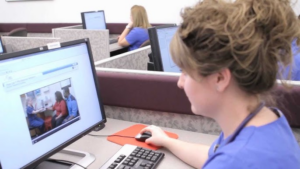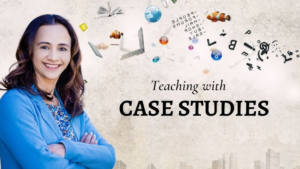Shadow Health Assignments
Using Reverse Case Studies for Learning in Clinical Settings
 As nursing educators, our job is to ensure that nursing students get the best education possible—both in the classroom and in clinical settings where they get hands-on experience.
As nursing educators, our job is to ensure that nursing students get the best education possible—both in the classroom and in clinical settings where they get hands-on experience.
Traditionally, we have used strategies like case studies and simulated clinical labs to help students learn. But with the COVID-19 pandemic, we were forced to rethink how we teach nursing students.
Many of the teaching methods we relied on became unavailable, especially with the shift to online nursing education.
This transition to virtual learning created several challenges for both students and educators, especially when it came to maintaining the essential clinical skills development that nursing students need.

Struggling to meet your deadline?
Get your assignment on Using Reverse Case Studies for Learning in Clinical Settings done by certified MDs and PhDs in the USA. ORDER NOW!
The move from traditional in-person classrooms to online learning platforms has not been easy. While online learning has its advantages, it can’t easily replicate real-life clinical experiences, such as working directly with patients or practicing skills in a hospital setting. Clinical nursing education during COVID-19 has been especially tough because of these challenges, but it has also forced us to come up with innovative clinical learning strategies to ensure nursing students don’t miss out on key experiences.
Adapting Clinical Education for Online Learning
Moving from in-person classes to teaching nursing students remotely presented a huge challenge. We had to come up with new methods to help students meet their learning goals without being in a physical classroom or clinical setting. But the real challenge was with clinical learning in nursing programs. In a normal setting, students would spend hours in hospitals or clinics, working with real patients. However, with COVID-19 restrictions, these opportunities were limited.
To adapt, many nursing programs turned to online nursing education tools and resources to keep clinical learning alive. We used virtual learning environments, recorded patient care simulations, and virtual patient cases. Yet, even with these resources, it remained difficult to replicate the feeling of actually being at a patient’s bedside. One strategy that has proven effective is using reverse case studies in nursing education.
What is a Reverse Case Study in Nursing Education?
A reverse case study in nursing education is a unique approach where students are presented with a brief description of a patient or a situation with limited information. They are then tasked with using their critical thinking in nursing education to diagnose the patient, create a care plan, and decide on the best course of treatment. This method of learning encourages active involvement, helps students build their decision-making skills, and allows them to “think like a nurse.”
The reverse case study method is based on the idea that nurses often have to make decisions with incomplete information. By learning how to make decisions in these types of situations, students can become better prepared for real-life clinical challenges. This approach is also helpful in preparing students for exams like the Next Generation NCLEX® Test Plan, which focuses on assessing clinical judgment and decision-making skills, rather than just rote memorization of facts. 
How Reverse Case Studies Support Clinical Learning
Reverse case studies are an excellent way to support clinical learning in both traditional and virtual clinical learning in nursing programs. They help students develop critical thinking skills by forcing them to assess a patient’s condition, think through possible solutions, and decide on the most appropriate care plan. This process of reasoning and decision-making is essential for nurses who must evaluate patient conditions quickly and make informed decisions.
By using reverse case studies, students can improve their clinical decision-making skills without needing direct patient contact. In the current environment, where direct clinical experience may be limited, reverse case studies provide an alternative way to continue practicing these essential skills.
Furthermore, reverse case studies allow for active learning nursing students, where students are not just passively receiving information but actively engaging with clinical scenarios. This encourages deeper learning and better retention of knowledge.
Implementing Reverse Case Studies in Online and Clinical Settings
Reverse case studies can be adapted to both online learning and in-person clinical settings. Here are a few ways to implement them:
- Brief Scenario and Medication List Approach:
- In this method, the educator provides a short clinical scenario and a list of medications. Students are expected to analyze the scenario and think through a diagnosis and treatment plan.
- Example for beginning students: A patient has just been diagnosed with diabetes. They need education on glucose testing, a diabetic diet, and insulin management.
- Example for intermediate students: A patient with a long history of diabetes requires surgery (like an amputation). Students are asked to review the patient’s medical history, medications, and propose a care plan.
- Example for advanced students: A patient with severe diabetes complications (such as diabetic ketoacidosis) comes into the emergency room. The students need to assess the patient’s symptoms and determine the next steps.
- Actual Clinical Assignment Approach:
- This method involves using real clinical data from hospitals or healthcare settings. Students are assigned to research and work through a real patient case, just like they would in a traditional clinical setting.
- Students are expected to develop a comprehensive care plan, research the patient’s condition, and reflect on their learning experience.
- While this approach requires access to clinical records and virtual conferencing platforms, it can still provide valuable clinical experience in an online environment.
Benefits of Reverse Case Studies in Nursing Education
Reverse case studies offer a variety of benefits for nursing education, particularly when traditional clinical experiences are not available:
- Develops Critical Thinking: Reverse case studies help develop critical thinking in nursing education by encouraging students to analyze situations and make decisions based on limited information.
- Supports Online Learning: This strategy is adaptable to online nursing education tools and can be done virtually, which is particularly helpful in the context of the pandemic or when clinical sites are unavailable.
- Aligns with NCLEX® Standards: Reverse case studies align with the Next Generation NCLEX® Test Plan, which tests the ability of nursing students to think critically and make clinical decisions.
- Encourages Active Learning: Students are encouraged to actively engage with the material, promoting deeper learning and better retention.
- Flexible for Different Learning Levels: Reverse case studies can be tailored to the level of the student (sophomore, junior, or senior) and adjusted to match the learning objectives for that stage of their education.
- Enhances Clinical Skills Development: Although they don’t replace direct patient care, reverse case studies are still a valuable tool for helping students build clinical decision-making and assessment skills.
Conclusion: The Future of Nursing Education
Looking ahead, reverse case studies offer a promising future for nursing education, particularly in a time when traditional clinical experiences might be difficult to provide. They help students think critically, make clinical decisions, and prepare for the Next Generation NCLEX® Test Plan—all essential aspects of becoming a successful nurse.
These innovative clinical learning strategies will continue to play a key role in nursing education, even after the pandemic. Whether used in online formats or integrated into traditional clinical settings, reverse case studies are a powerful tool for developing the skills nurses need to succeed in today’s healthcare environment.
By incorporating reverse case studies in nursing education, we can ensure that nursing students continue to develop the knowledge, skills, and critical thinking abilities they need to provide safe, effective care to patients—no matter what challenges we face in the future.
References
- Atkinson, T. (2014). The “Reverse Case Study:” Enhancing creativity in case-based instruction in leadership studies. Journal of Leadership Education, 13(3), 118-128.
- Beyer, D.A. (2011). Reverse case study: To think like a nurse. Journal of Nursing Education, 50(1), 48-50.
- Smallheer, B.A. (2016). Reverse case study: A new perspective on an existing teaching strategy. Nurse Educator, 41(1), 7-8.

Dont wait until the last minute.
Provide your requirements and let our native nursing writers deliver your assignments ASAP.